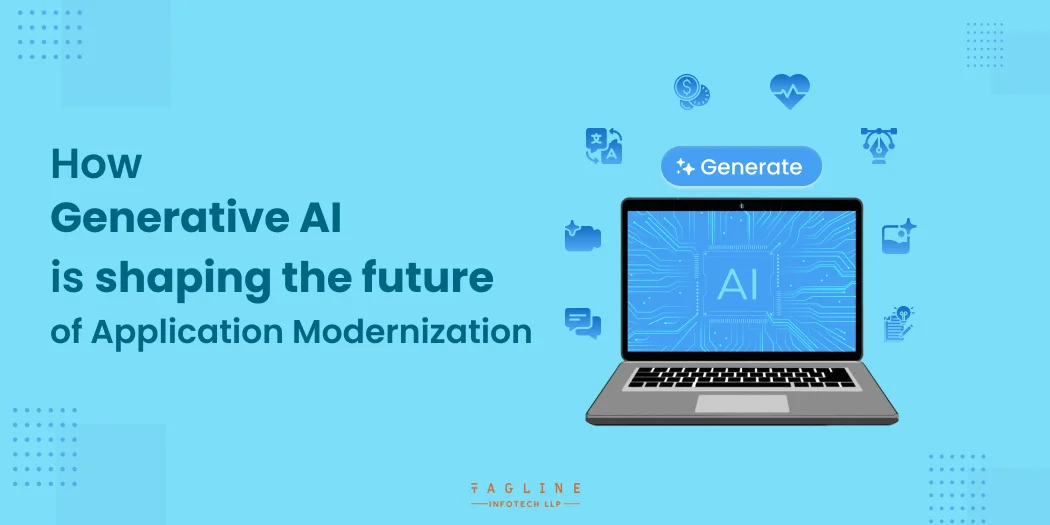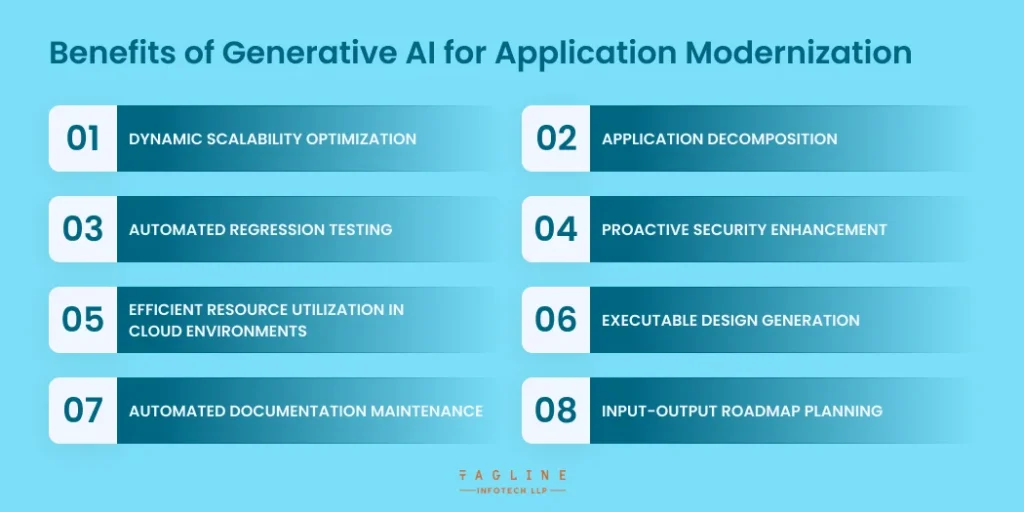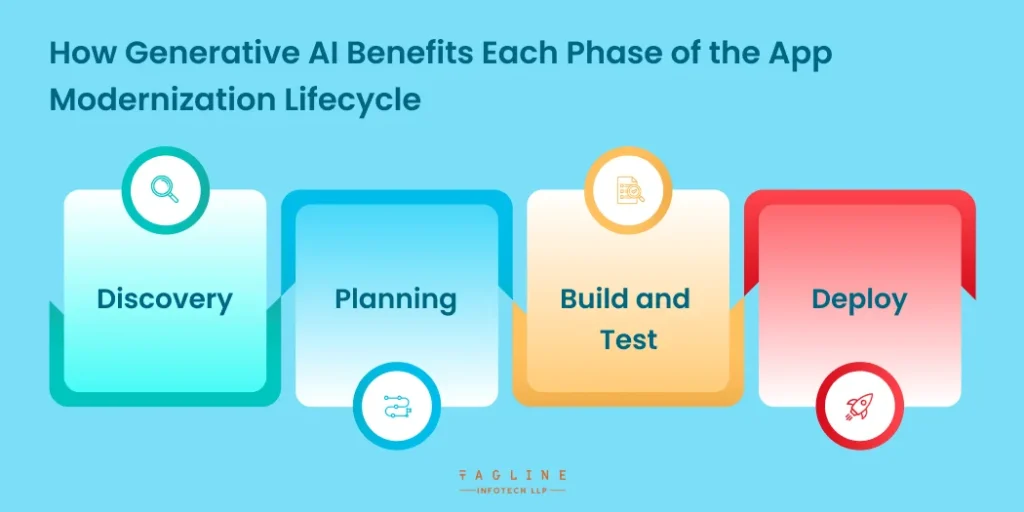Role of Python Libraries in Image Processing
October 30, 2025
Home >> AI >> How Generative AI is shaping the future of Application Modernization

You know about the influence of generative AI (Yes, ChatGPT-like) right? But did you know it can help you modernise your legacy app? Go through this inclusive guide and get expert insights from developers who modernise for a living. Read on!
It’s been 6+ years since Tagline modernized the first legacy app. Hundreds of projects later, the dynamics and scale of app modernization didn’t stop changing.
Our team has successfully migrated monolithic architectures to microservices, improved the speed and performance of outdated systems, and helped companies keep up with the digital world, as we did (one of many) for this Us – based company.
In any case, the new technology was so transformative that companies had to rethink and recreate their existing applications through comprehensive Application Modernization.
Today, as the demand for sheer volume and limitless scalability continues to grow, it becomes evident that we need a different approach to innovation, with a different technology altogether.
And it’s happening with Generative AI.
Generative AI has gained increasing attention recently, especially with the growing popularity of technologies like ChatGPT (as seen in a notable rise in searches in early 2023).
Generative AI, a subset of artificial intelligence, uses advanced machine learning techniques to analyze large datasets and create new content in various forms such as text, images, and audio.
What makes generative AI unique is its autonomy—it operates independently, learning from data patterns without relying on predefined rules typical of traditional AI models. This ability allows it to generate original and diverse outputs based on the information it processes.
This breakthrough in deep learning has significantly expanded the applications of generative AI, covering tasks such as image generation, natural language processing, and even complete application development.
Application Modernization Using Generative AI leverages the technology’s capability to autonomously generate code snippets, design elements, or even entire applications, marking a significant advancement in both application modernization and technological innovation. As its capabilities continue to evolve, generative AI holds immense promise for transforming various industries with its creative and adaptive potential.
Integrate Modern AI Capabilities to Modernise Your App That Demands a Future-Ready Edge
Keeping up with an older version application may not be easy especially when the group of employees is getting bigger or the concerned technology is getting more complex. Combined with a general increase in the complexity and size of the app, the process of sustaining legacy apps is turning into an expensive proposition that is complex and difficult to test and modify at the same time.
Generative AI provides the solution with an increased work rate, more precise results, and within a shorter time – up to 15 times more effective than previous techniques. This is done through the automation of tasks, noteworthy intelligent design solutions offered, and the general facilitation of the use of infotech.
Now let us discuss some of the core issues in app modernization and how generative AI dispels them:
Legacy applications frequently contain complicated and outdated code, making the manual rewriting process slow and susceptible to errors.
Generative AI plays a crucial role in modernizing applications by evaluating current codebases and refactoring them automatically.
By recognizing patterns and conducting a thorough analysis, it identifies areas for enhancement, optimizes the code structure, and incorporates contemporary best practices.
Shifting from a monolithic architecture to microservices poses a significant challenge. It involves identifying the best service boundaries and ensuring smooth inter-service communication.
Generative AI can greatly facilitate this transition by analyzing dependencies and usage patterns within the monolithic application.
To streamline the process, it recommends optimal service boundaries and effective communication protocols, helping teams transition more efficiently.
Keeping up with modern trends like blockchain, IoT, and machine learning is crucial for today’s applications. However, manually integrating these technologies can be complex and time-consuming.
Generative AI can simplify this process by understanding the intricacies of emerging technologies and generating intelligent integration patterns.
This includes automatically creating the necessary code snippets, connectors, and interfaces tailored to the specific technology, making the integration process smoother and more efficient.
With the wide variety of devices and operating systems available today, ensuring cross-platform compatibility is a persistent challenge.
Generative AI excels at understanding the nuances of different platforms and can generate code that adapts seamlessly to various environments, be it mobile, web, or desktop applications.
This significantly reduces the need for extensive manual adjustments, allowing teams to focus on other critical tasks.

A recent survey reveals that 92% of organizations are currently engaged in at least one app modernization project.
Consider IKEA’s success story: they saw a 300% increase in online sales after modernizing the payment processing system of their eCommerce app.
As this trend grows, it becomes clear that leveraging generative AI for app modernization is a powerful driver for achieving greater efficiency and fostering innovation.
Generative AI can enhance scalability by analyzing application workloads and performance data. This allows it to optimize code for dynamic scaling, ensuring that the app architecture uses resources efficiently and performs well under different loads, all without manual intervention.
Generative AI shines in breaking down monolithic applications into microservices. It assesses the current architecture and suggests the best service boundaries based on code dependencies and usage patterns. This helps teams transform complex applications into manageable, modular components, easing the transition to a microservices architecture.
By leveraging generative AI, automated regression testing becomes more robust. The AI generates diverse test cases that cover a wide range of scenarios, helping to identify and fix issues that arise during the modernization process, thus ensuring thorough quality assurance.
Generative AI proactively improves security by detecting potential vulnerabilities in legacy code and recommending secure coding practices. This approach helps prevent data breaches and unauthorized access, significantly boosting the application’s security.
In cloud environments, generative AI can optimize resource utilization by creating cloud-native code that leverages platform-specific features. This leads to more efficient use of resources and better overall performance.
Generative AI takes design beyond theory by creating executable designs from high-level requirements. These functional prototypes allow developers to interact with early versions of the modernized application, speeding up design validation and ensuring alignment with user needs.
Generative AI also streamlines documentation by updating it in real time as the code changes. This ensures that documentation remains accurate and up-to-date throughout the modernization process.
Generative AI assists in planning the input-output roadmap for application modernization by analyzing data flows and identifying optimal sequences for data interactions. This results in a well-structured and efficient modernization strategy.

The application modernization process is a series of well-defined stages, each with specified deliverables and milestones. The goal of this systematic approach is to successfully migrate and modernize legacy apps.
Generative AI significantly reduces the need for extensive input from subject matter experts. It excels at tasks such as analyzing code, extracting insights from outdated documents, and linking domain or functional capabilities to both code and data. This leads to more effective decomposition exercises, event-storming, and domain-driven design. By providing better visibility into legacy applications and their dependencies, generative AI helps mitigate risks and improve the efficiency of the discovery and design stages.
Generative AI leverages historical data to generate comprehensive roadmaps, considering an application’s domain maps, complexity factors, and dependency patterns. This enables continuous realignment through Program Increments (PIs) and effectively balances parallel efforts with sequential dependencies. It correlates application portfolio details with discovered dependencies, making planning more informed and adaptable.
In the build phase, generative AI goes beyond just generating code. It produces related artifacts like security design points, pipeline configurations, and Infrastructure as Code (IaC) based on Swagger specifications or legacy code insights. These outputs are orchestrated using predefined application reference architectures. For the testing phase, generative AI helps create detailed test codes, test cases, and test data, ensuring thorough testing coverage.
Deploy
Generative AI simplifies critical deployment activities, speeding up security validation by analyzing Infrastructure-as-Code, application logs, and design points. It also generates inputs for configuration and change management, streamlining the release process. By extracting insights from release notes, generative AI improves the efficiency of security review and approval processes
For many CTOs and CIOs, exploring app modernization solutions empowered by advanced AI can be a challenging endeavor.
In the rapidly evolving tech landscape, new technologies often arrive amid high expectations but frequently fail to deliver tangible results.
Yet, advanced AI holds significant promise beyond mere buzz. It marks a pivotal shift in enterprise AI, offering a fresh approach to app modernization.
Here are key considerations to maximize this potential:
1. Strike a balance between deploying robust, general-purpose AI models and refining specialized ones, carefully weighing costs and benefits.
2. Evaluate the intricacies and expenditures tied to data accessibility, governance, security, and sustainability.
3. Gauge your organization’s readiness in managing hybrid cloud environments, crucial for effectively integrating advanced AI solutions.
4. Analyze the obstacles and costs associated with maintaining current app modernization strategies.
5. Work closely with Human Resources to prioritize the human element in driving your advanced AI strategy.
By taking these steps, organizations can effectively leverage advanced AI to redefine and enhance their app modernization initiatives.
Given the current state of the world where technology is advancing at rapid rates, what is needed is an app that adapts, scales, and thrives. Contact Tagline Infotech for code optimization services, and leave the rest to us as we work on transforming your application code to be bright for the operational AI future. So when you choose our App Modernization Solutions, you know your app is going to be up-to-date, efficient, and fully prepared for the future.
Thus, with our assistance, your app won’t only ensure the fulfillment of the current needs but also be ready for changes due to further developments in the field of IT. You can rely on Tagline Infotech to deliver the best when your application is converted to a highly scalable solution capable of being adapted to your business needs. Choose our brilliant app modernization services, and we will lead the way to an efficient and promising future.
In today’s swiftly advancing tech landscape, artificial intelligence (AI) has become integral for optimizing and enhancing applications. It’s no longer just a nice-to-have feature; it’s now a must-have for businesses looking to maintain their competitive edge. Companies of all sizes, whether small startups or large enterprises, are increasingly turning to AI to boost the intelligence and functionality of their applications.
At Tagline Infotech, we recognize the critical role that AI plays in helping businesses effectively upgrade their applications. Our approach is straightforward: we integrate advanced AI throughout the entire development lifecycle. This includes refining code quality, optimizing project workflows, and utilizing AI insights to enhance app speed and usability.
With a proven track record of successful projects, our team is committed to maximizing AI’s benefits for your business. We specialize in crafting tailored solutions that propel your app updates forward and yield exceptional outcomes.
If you’re keen to explore how AI can elevate your applications and drive business growth, contact us today. Partner with Tagline Infotech to Hiring AI Developers to leverage AI for success and innovation in today’s digital era.
Effective change management when integrating generative AI tools into app modernization includes several key practices:
- Clear Communication: Ensure stakeholders understand the benefits and goals of AI integration.
- Comprehensive Training: Provide thorough training to equip teams with necessary AI skills.
- Cultural Adaptability: Foster a culture that embraces change and innovation.
- Early Stakeholder Involvement: Involve key stakeholders from the beginning to gain support and insights.
- Feedback Loop: Establish a mechanism for gathering feedback to refine and improve AI implementations continuously.
Implementing generative AI in app modernization involves several critical architectural considerations. Firstly, selecting a scalable and resilient infrastructure capable of meeting the computational requirements of generative AI algorithms is essential. Moreover, opting for a modular and adaptable architecture facilitates seamless updates and adjustments as the AI model progresses and improves over time. These architectural decisions play a pivotal role in ensuring the effectiveness and longevity of AI-driven modernization initiatives.
Businesses can secure the ongoing effectiveness of generative AI in modernizing applications by prioritizing continuous talent development. This involves cultivating expertise in AI technologies and staying updated with advancements in the field. Furthermore, fostering an innovative culture that encourages experimentation enables businesses to fully leverage generative AI's capabilities. Flexible adoption strategies also play a pivotal role, allowing businesses to swiftly adapt to evolving market dynamics and technological advancements, thereby maintaining a competitive edge over time.
To ensure the secure adoption of generative AI for application modernization, businesses should implement the following security precautions:
By adhering to these security measures, businesses can effectively mitigate risks and ensure a secure environment for integrating generative AI into their application modernization strategies.
Created with Solvase

Digital Valley, 423, Apple Square, beside Lajamni Chowk, Mota Varachha, Surat, Gujarat 394101
D-401, titanium city center, 100 feet anand nagar road, Ahmedabad-380015
+91 9913 808 2851133 Sampley Ln Leander, Texas, 78641
52 Godalming Avenue, wallington, London - SM6 8NW